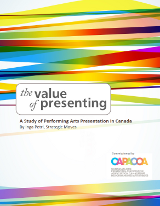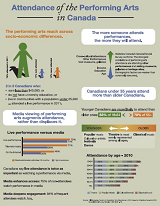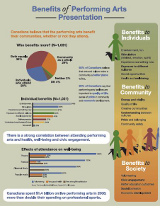The Value of Presenting: A Study of Performing Arts Presentation in Canada is the culmination of two years of intensive action research, which involved two pan-Canadian surveys, and consultations of more than 1,000 stakeholders.
This report includes a comprehensive historical and contemporary overview of the performing arts ecosystem. It reveals that performing arts are valued by the vast majority of Canadians – across socio-economic differences – and it provides a new perspective on younger Canadians’ interest in live performing arts. Most importantly, the study identifies a broad range of public benefits associated with performing arts presentation, including better health and well-being, greater energy and vitality in communities, and a more caring and cohesive society.
 |
 |
 |
||
| Read the full report | View the infographic | View the infographic |
Key Findings
Canadians value the performing arts, with 3 in 4 reporting attending a wide range of live events.
- Professional performing arts reach across socio-economic differences with 2 in 3 who earn less than $40,000 per year having attended a live performance.
- Younger Canadians embrace live performing arts at high levels: 83% of the 18-34 age group attended a live performance compared to 70% of 55 plus.
Canadians attend events predominantly in specialized performing arts facilities and outdoor venues, and most say these facilities are important to the quality of life in their communities.
- Canadians believe that performing arts venues provide benefits such as improved quality of life (87% say moderate to high importance), fostering a sense of community pride (87%), contributing to economic development (88%), and greater community safety through increased activity at night (60%).
Canadians are invested in performing arts presentation through ticket buying, volunteering and donating.
- Canadians’ spending on live performing arts ($1.4 billion) was more than double their spending on live sports events ($650 million) in 2008.
- Canadians volunteered 100 million hours for arts and culture organizations in 2010.
- For each paid staff member, there are 17 volunteers giving their time to performing arts presenting organizations.
Media viewing of performing arts doesn’t replace live attendance; it supplements it.
- 86% of Canadians are accessing performing arts presentations via television, Internet or other media channels.
- 94% of people who attend live performances also watch performances in media.
- Canadians are twice as likely to ascribe a high importance to live performing arts attendance than to any media-based viewing.
Performing arts benefits span many aspects of life.
- Canadians believe that the presentation of performing arts equally benefits the individual who attends and the community as a whole.
- Canadians who attend performing arts events are first and foremost looking for a fun, entertaining experience (84%). They are also seeking emotional, intellectual or spiritual stimulation (58%), as well as the opportunity to experience or learn something new (57%).
- For Canadians, the highest-rated benefits of the performing arts in their communities are energy and vitality along with improved quality of life, and a more creative community.
- The broader society also benefits from the spill-over effects of the performing arts on health, education, social cohesion and economic development.
Performing arts presenters of all types play an active role in communities across Canada.
- There are more than 1,400 presenting organizations of all types in Canada: volunteer presenters and professionally-run organizations, based in a purpose-built theatre or operating in non-specialized venues, presenting festivals and series of performances, specialized in a single artistic form or presenting several disciplines such as music, theatre, dance, comedy and storytelling.
- Nearly all presenters partner with other organizations, in areas such as education (78%) social services (37%), cultural diversity/immigration (33%) and health (29%). The main objective of these partnerships is the enrichment of the community (84%).
The Ripple Effect of the Performing Arts from CAPACOA on Vimeo.

